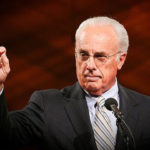 Chris Castaldo (PhD, London School of Theology) serves as lead pastor of New Covenant Church in Naperville, Illinois. He is the author of Talking with Catholics about the Gospel and co-author of the recently released The Unfinished Reformation: What Unites and Divides Catholics and Protestants After 500 Years. Chris blogs at www.chriscastaldo.com. (original source of this article found here)
Chris Castaldo (PhD, London School of Theology) serves as lead pastor of New Covenant Church in Naperville, Illinois. He is the author of Talking with Catholics about the Gospel and co-author of the recently released The Unfinished Reformation: What Unites and Divides Catholics and Protestants After 500 Years. Chris blogs at www.chriscastaldo.com. (original source of this article found here)
“I will build my church,” Jesus declared (Matthew 16:18). And what a magnificent and agonizing process has unfolded for two millennia. Essential to this work is the formation of living stones — men and women drawn from the quarry of sin, whose lives now testify to gospel grace.
But how does Christ construct his church? One answer is suggested inside the dome of St. Peter’s Basilica in Rome, in letters six feet tall, where Christ’s promise is written in Latin: “Thou art Peter, and upon this rock I will build my church . . .” Illumined by encircling windows, these words sit as a crown atop the crypt of the apostle himself, who is hidden far beneath the high altar, a reminder of the authority given to Peter’s heir who sits upon the papal throne.
Martin Luther was not the first to question papal authority, but his argument was especially incisive. When Luther’s ideas began to congeal in 1520, he articulated his concerns in a seminal work: To the Christian Nobility. This treatise was occasioned by attacks from the pope’s theologian, Sylvester Prierias, who asserted papal absolutism with such bravado that Luther called it a “hellish manifesto.” Convinced of Scripture’s supreme authority, and believing German nobility to be sympathetic to his position, Luther, in light of historical precedent, urged nobles to embrace the responsibility of church reform.
Luther’s treatise laid an ax at the Roman institution — the social, political, legal, and religious conventions that undergirded Western Christendom. Of central concern was the papal claim (championed by Prierias) that only the pope can reliably interpret Scripture and speak without error. Luther viewed such traditions as religious accretions that threatened the church’s integrity if not eradicated.
Looking back, we sometimes wonder how the accumulation of Roman tradition developed from the Galilean’s fishing boat to Luther’s day; that is, from the day of Pentecost to the sixteenth century. While the story is protracted and complex, the following overview will attempt to offer some perspective, giving particular attention to the development of ecclesial authority in the papal office.
First Pope
Our story begins with a reminder from Lord Acton who suggested the best way to ensure the cogency of one’s position is to make the best possible argument for those we believe are wrong. While the following narrative is not an argument per se, it is intended to demonstrate that the misguided trajectory of papal authority developed rather naturally in the scope and sequence of Western history, a development that cautions followers of Christ in every age.
Catholic historians typically acknowledge that there is no straight line from the current pope to the apostle Peter. In the words of Eamon Duffy, “There is, therefore, nothing directly approaching a papal theory in the pages of the New Testament,” and from all indications, “there was no single bishop of Rome for almost a century after the deaths of the apostles.”
It was around 150 AD when the loose pattern of presbyterial authority began to give way to a single Roman bishop, an office that eventually developed into a monarchical position under Bishop Victor (189–198) and to a greater extent under Bishop Stephen I (254–257) who claimed some of the powers and honors attributed to the apostle Peter. Stephen’s invocation of Matthew 16 was the first instance of a bishop of Rome attempting to elevate himself over other bishops with an authority that was qualitatively superior.
The conversion of Constantine, and his subsequent investment in church institutions, placed Roman bishops at the center of imperial life. They soon became affluent and politically engaged potentates, acquiring the urbane trappings of aristocracy. The bishop’s political influence increased when Constantine transferred the capital of the empire to Constantinople in 330, a move that left Rome’s bishop as the single most important individual in the city. But which of these bishops should be considered the first pope? Continue reading

